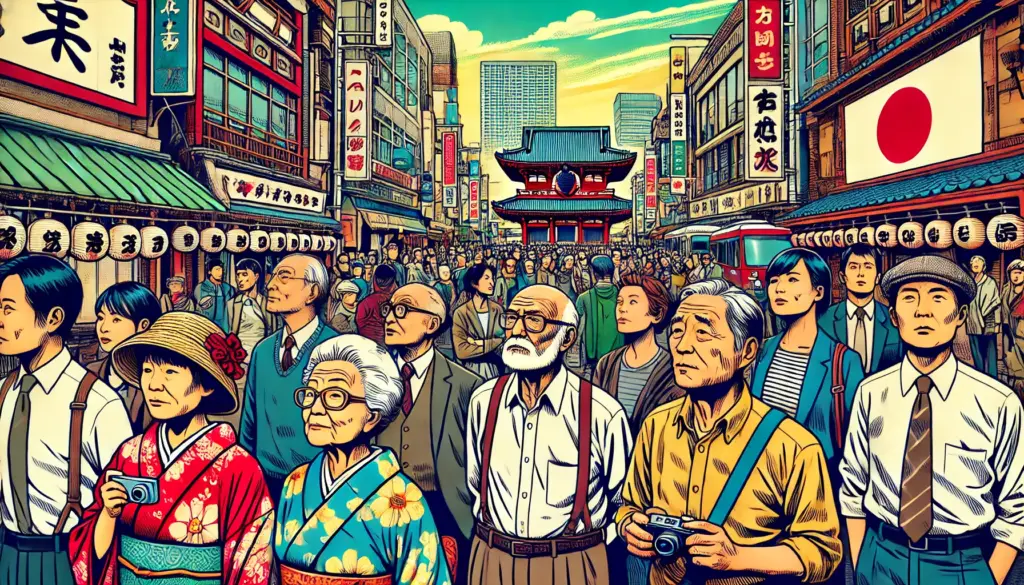
When I ponder how the so-called “Ugly Japanese” generation—sometimes labeled as “Japanese Locusts”—feels about today’s overtourism in Japan, several threads emerge: nostalgia, awareness, and a wry sense of justice. Let me walk you through this.
1. Who Were the “Ugly Japanese,” Anyway?
Back in the late 1980s and early 1990s, a wave of Japanese tourists abroad gained notorious reputations. This was the era when Japan’s wealth soared, the yen was strong, and travel exploded. Unfortunately, many Japanese travelers didn’t always show cultural sensitivity or polite manners—some behaved in ways that offended locals, crowded sacred sites, or drew sharp public criticism overseas. The rude label “Ugly Japanese” or even “Japanese Locusts” captured how this overconfident tourist wave was perceived globally. But what about now, when Japan itself is flooded with visitors?
2. Who Are They Today—And How Old?
Those pictured as “Ugly Japanese” back then were typically young to middle-aged Japanese in their late teens, twenties, or thirties. That places them solidly in Generation X, born roughly between 1965 and 1980. That means that today, in 2025, they’re roughly 45 to 60 years old.
Their youth coincided with Japan’s bubble economy, and as they traveled more freely than previous generations, they sometimes lacked the international etiquette that might have been appreciated. Now, those individuals are in mid-career or nearing retirement—a demographic often reflective, with the confidence to self-critique.
3. A Mirror Held to Overtourism
Fast-forward to today: Japan is wildly popular as a travel destination, burdened now with overtourism—crowds in temples, long lines at train stations, behavior that sometimes destabilizes local rhythms. I imagine many from the Ugly-Japanese generation experience a strange mix of schadenfreude and solemn responsibility:
- Schadenfreude, because the world is now glimpsing what Japan once projected overseas.
- Responsibility, as many still guide the country—through leadership, media, or as grandparents—and feel the need to correct course.
One might picture a conversation at a family dinner:
“Remember how we were on the wrong side of manners abroad? Let’s not be like that here.”
That awareness—born from regret—can spark more mindful travel and tourism behavior today.
4. Generational Reflections on Cultural Behavior
Pride and remorse
There’s complicated pride: they helped globalize Japan — and remorse: they inadvertently contributed to a grouchy image. Now, as tourists swarm Japan’s backstreets and shrines, that bitter irony isn’t lost on them.
Empathy meets action
Compared to younger generations, those born in the late 1960s to 1970s often champion etiquette—encouraging politeness in line formation, reduced noise on public transport, and respect for local norms. They may be creating subtle norms of considerate tourism.
Seeking balance
Many of them long for a Japan where tourism boosts the economy without diluting local life. They may support measured tourism management: ticketing systems at popular spots, limits on group sizes, encouragement of lesser-known regional travel, or fostering off-season visits.
5. Lost Lessons—and How to Rediscover Them
The forgotten truth? It’s easy to forget that Japanese tourist behavior was once criticized—because now we talk so much about foreign behavior in Japan instead. Re-centering that memory can be transformative.
What can be done?
- Public campaigns rooted in history
- For example, museums or travel agencies could feature modest retrospectives: “In the 1980s, Japanese tourists abroad were criticized for rudeness. Now, we must extend the courtesy inward.”
- Storytelling from the generation itself
- Podcasts or local news segments featuring interviews: “How we were wrong—and what we learned.”
- Grassroots community involvement
- Local guides, especially seniors, might help visitors navigate etiquette—like quiet zones, no-go times for certain shrines, or simple respectful behaviors.
6. A Personal Perspective
Personally, I find this generational mirror fascinating. The Ugly-Japanese generation is uniquely positioned—they experienced the shame and now witness its echo come home. Watching them quietly steer the tourism culture toward mindfulness feels hopeful.
They often carry deep, nuanced pride: of having once made Japan visible to the world, and now gently guiding the world—and their own country—toward awareness. In that sense, they are both bearers of lessons and living bridges between Japan’s travel past and its overtourism present.
7. Final Thoughts
- The Ugly Japanese generation now stands between past missteps and future solutions.
- They are aged roughly 45–60 years old—seasoned, reflective, and uniquely aware.
- Overtourism in Japan reflects, in part, a return of earlier mistakes; but it also offers a chance to correct course.
- With their historical perspective, they can—and often do—encourage more thoughtful, respectful tourism.
Let’s hope they continue to lead with humility, turning “the mistakes of the past” into “mindful steps forward.”



















































